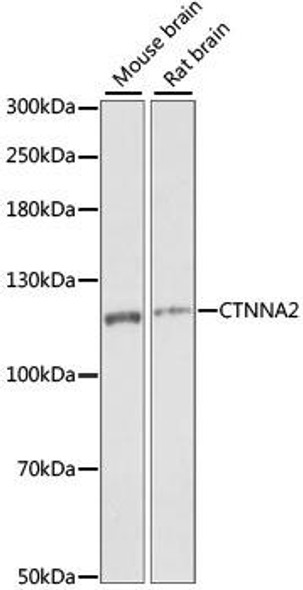Description
CTNNA1/CTNNA2 Antibody (PACO00525)
The CTNNA1/CTNNA2 Polyclonal Antibody (PACO00525) is a valuable tool for researchers studying CTNNA1 and CTNNA2, two proteins involved in cell adhesion and signaling pathways. This antibody, produced in rabbits, exhibits high specificity and sensitivity towards human samples, making it suitable for use in Western blot applications.CTNNA1 and CTNNA2 are members of the catenin family of proteins, which play essential roles in maintaining cell-cell adhesion and tissue integrity. Dysregulation of these proteins has been linked to various diseases, including cancer and developmental disorders.
By targeting CTNNA1 and CTNNA2, researchers can investigate their functions in cellular processes and disease pathways.Overall, the CTNNA1/CTNNA2 Polyclonal Antibody (PACO00525) is a valuable tool for researchers interested in understanding the roles of CTNNA1 and CTNNA2 in health and disease. Its high reactivity and specificity make it a reliable choice for studies in cell biology, cancer research, and other fields related to cell adhesion and signaling.
| Antibody Name: | CTNNA1/CTNNA2 Antibody |
| Antibody SKU: | PACO00525 |
| Size: | 50ug |
| Host Species: | Rabbit |
| Tested Applications: | ELISA, WB, IHC, IF |
| Recommended Dilutions: | WB:1:500-1:2000, IHC:1:100-1:300, IF:1:200-1:1000 |
| Species Reactivity: | Human, Mouse, Rat |
| Immunogen: | synthesized peptide derived from the C-terminal region of human Catenin-alpha E/N. |
| Form: | Liquid |
| Storage Buffer: | Liquid in PBS containing 50% glycerol, 0.5% BSA and 0.02% sodium azide. |
| Purification Method: | The antibody was affinity-purified from rabbit antiserum by affinity-chromatography using epitope-specific immunogen. |
| Clonality: | Polyclonal |
| Isotype: | IgG |
| Conjugate: | Non-conjugated |
| Synonyms: | CTNNA1; Catenin alpha-1; Alpha E-catenin; Cadherin-associated protein; Renal carcinoma antigen NY-REN-13; CTNNA2; CAPR; Catenin alpha-2; Alpha N-catenin; Alpha-catenin-related protein |
| UniProt Protein Function: | CTNNA1: Associates with the cytoplasmic domain of a variety of cadherins. The association of catenins to cadherins produces a complex which is linked to the actin filament network, and which seems to be of primary importance for cadherins cell-adhesion properties. Can associate with both E- and N-cadherins. Originally believed to be a stable component of E-cadherin/catenin adhesion complexes and to mediate the linkage of cadherins to the actin cytoskeleton at adherens junctions. In contrast, cortical actin was found to be much more dynamic than E-cadherin/catenin complexes and CTNNA1 was shown not to bind to F-actin when assembled in the complex suggesting a different linkage between actin and adherens junctions components. The homodimeric form may regulate actin filament assembly and inhibit actin branching by competing with the Arp2/3 complex for binding to actin filaments. May play a crucial role in cell differentiation. Monomer and homodimer; the monomer preferentially binds to CTNNB1 and the homodimer to actin. Binds MLLT4 and F-actin. Possible component of an E-cadherin/ catenin adhesion complex together with E-cadherin/CDH1 and beta-catenin/CTNNB1 or gamma- catenin/JUP; the complex is located to adherens junctions. The stable association of CTNNA1 is controversial as CTNNA1 was shown not to bind to F-actin when assembled in the complex. Alternatively, the CTNNA1-containing complex may be linked to F- actin by other proteins such as LIMA1. Interacts with ARHGAP21 and with AJUBA. Interacts with LIMA1. Expressed ubiquitously in normal tissues. Belongs to the vinculin/alpha-catenin family. 2 isoforms of the human protein are produced by alternative splicing. |
| UniProt Protein Details: | Protein type:Motility/polarity/chemotaxis; Actin-binding Chromosomal Location of Human Ortholog: 5q31.2 Cellular Component: focal adhesion; lamellipodium; acrosome; plasma membrane; catenin complex; zonula adherens; intercellular junction; cytosol; actin cytoskeleton Molecular Function:actin filament binding; protein binding; cadherin binding; gamma-catenin binding; beta-catenin binding; structural molecule activity; vinculin binding Biological Process: intercellular junction assembly and maintenance; apical junction assembly; gap junction assembly; protein heterooligomerization; axon regeneration; male gonad development; establishment and/or maintenance of cell polarity; actin filament organization; odontogenesis of dentine-containing teeth; muscle cell differentiation; negative regulation of neuroblast proliferation; ovarian follicle development; response to estrogen stimulus; positive regulation of smoothened signaling pathway; positive regulation of muscle cell differentiation; cell adhesion; vascular endothelial growth factor receptor signaling pathway; aging |
| UniProt Code: | P35221 |
| NCBI GenInfo Identifier: | 461853 |
| NCBI Gene ID: | 1495 |
| NCBI Accession: | P35221.1 |
| UniProt Secondary Accession: | P35221,Q12795, Q8N1C0, |
| UniProt Related Accession: | P35221 |
| Molecular Weight: | 59,550 Da |
| NCBI Full Name: | Catenin alpha-1 |
| NCBI Synonym Full Names: | catenin (cadherin-associated protein), alpha 1, 102kDa |
| NCBI Official Symbol: | CTNNA1 |
| NCBI Official Synonym Symbols: | CAP102 |
| NCBI Protein Information: | catenin alpha-1; alpha-catenin; alphaE-catenin; alpha E-catenin; alpha-E-catenin; renal carcinoma antigen NY-REN-13; cadherin-associated protein,102kDa |
| UniProt Protein Name: | Catenin alpha-1 |
| UniProt Synonym Protein Names: | Alpha E-catenin; Cadherin-associated protein; Renal carcinoma antigen NY-REN-13 |
| Protein Family: | Catenin |
| UniProt Gene Name: | CTNNA1 |
| UniProt Entry Name: | CTNA1_HUMAN |










